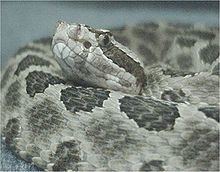Kingdom Animalia Suborder Serpentes Subfamily Crotalinae Phylum Chordata Rank Subspecies | Subphylum Vertebrata Family Viperidae Genus Sistrurus Higher classification Massasauga Order Scaled reptiles | |
 | ||
Scientific name Sistrurus catenatus tergeminus Similar Sistrurus, Massasauga, Snake, Sistrurus catenatus, Reptile | ||
Sistrurus catenatus tergeminus rattling
Sistrurus catenatus tergeminus is a venomous pit viper subspecies found in the southwestern plains of the United States. In some areas its range overlaps that of another subspecies, S. c. edwardsii, and intergrading of the two is not unknown.
Contents
- Sistrurus catenatus tergeminus rattling
- Sistrurus catenatus tergeminus 2
- Description
- Common names
- Geographic range
- Behavior
- Venom
- References
Sistrurus catenatus tergeminus 2
Description
Adults range in size from 35 to 91 cm (14 to 36 in). The standard length for 43 male and 63 female adult specimens was 68 cm (27 in). Conant (1975) mentions an average length of 46–66 cm (18–26 in), with a maximum of 88.3 cm (34 3⁄4 in).
The color pattern is similar to that of S. c. catenatus, but paler: the dark brown blotches contrast strongly with the tan-gray or light gray ground color. The venter (belly) is light with a few dark markings.
Common names
Western massasauga, ground rattlesnake, Gulf Coast massasauga, Edward's massasauga, large ground rattlesnake, Say's false rattlesnake, Sonora ground rattlesnake, Texas massasauga, three-spotted shield rattler, triple-spotted rattlesnake.
Geographic range
Found in the United States in the southwestern plains from extreme southeastern Nebraska and northwestern Missouri, southwest through east-central Kansas and west-central Oklahoma into northern and central Texas about as far southwest as the Colorado River. The type locality given is "between the Mississippi River and the Rocky Mountains".
Behavior
Primarily found in grassland areas, on the edge of open woodland, or on rocky hillsides, and often makes use of the burrows of other animals for shelter. They primarily eat rodents, but they may also eat lizards and frogs. Their rattles are significantly higher pitched than those of larger species of rattlesnake, sometimes giving them the nickname buzztail. They are primarily nocturnal, especially during the summer months when it is too hot for them to be active, but they will sometimes be found out sunning themselves. They are most often found immediately after rain storms.
Venom
Drop for drop, massasauga venom is more potent than that of many larger species of rattlesnake, but due to the lower yield (the amount it is capable of delivering in a single bite) its potential for harm is greatly reduced. The venom is a powerful hemotoxin which can cause swelling, necrosis, and severe pain. Despite its smaller size and less severe bite, envenomation can still be fatal if untreated, and treatment should be sought immediately for any venomous snake bite. The antivenin CroFab, while not type-specific, can be used to treat severe envenomations from massasaugas.
